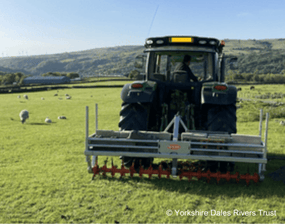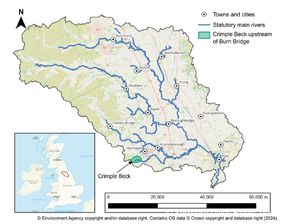Rising waters | Rooted solutions
Unlocking the power of monitoring for natural flood management

By testing how aeration improves soil water storage, we can better understand its role in reducing flood risk. We need the help of local farmers to make this a reality.
At Ousewem, we believe that data-driven decision-making is key to unlocking the full potential of natural flood management (NFM). While models help predict how interventions might perform, real-world monitoring provides the evidence needed to refine those predictions, improve outcomes, and secure long-term investment in nature-based solutions.
One such opportunity is our proposed soil aeration monitoring. By testing how aeration improves soil water storage, we can better understand its role in reducing flood risk and supporting healthier catchments. However, we need the help of local farmers to make this a reality.
Why monitoring matters for NFM
Monitoring helps to bridge the gap between theoretical models and practical understanding. Through continuous data collection - on soil moisture, river flow, and other environmental factors - we can validate our models, adjust interventions where needed, and demonstrate the tangible benefits of NFM.
Ousewem is actively working to:
- validate and improve models - comparing real-world data with predictions ensures we get the most accurate insights
- tailor interventions to local conditions - every catchment responds differently to NFM. Monitoring helps us understand these variations and design more effective solutions
- demonstrate success to landowners and policymakers - transparent, evidence-based results encourage investment and participation in NFM projects
Soil aeration
Soil aeration is the mechanical loosening of soils, particularly on land compacted by livestock.
Improving the air circulation in soils increases nutrient cycling, water infiltration and improves productivity of sward. In addition to soil health benefits, soil aeration could help reduce surface runoff and enhance flood resilience.
A call for farmers and landowners
To test its effectiveness for NFM, we're looking to carry out trials of soil aeration in the upper catchments of the River Nidd, specifically Crimple Beck upstream of Burn Bridge. Soil moisture sensors will also be used to help show how infiltration and saturation changes from before and after aeration is carried out.

This area has been chosen because it is a good example of typical land use and farming practices across the wider Ouse catchment. There is potential for aeration here to have benefits at a local level, by improving soil health in field, but also contributing to benefits for flood risk and water quality for communities downstream, including York.
Get involved
By taking part, you can:
- find out more on how soil aeration benefits your land
- help us understand how aeration works for flood management in the Nidd
- support efforts to build a more resilient local landscape
Next steps
Are you a farmer in the Crimple Beck at Burn Bridge who could help? Or do you know someone who might be interested? Get in touch with us today to find out more and to arrange an initial soil assessment.

Also see

